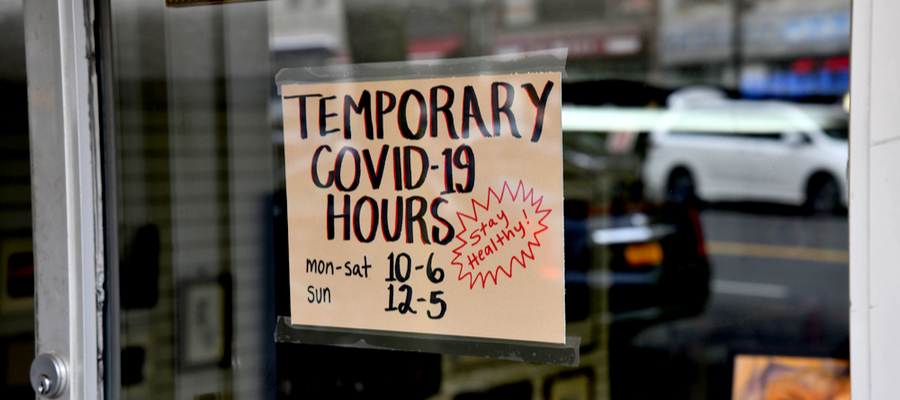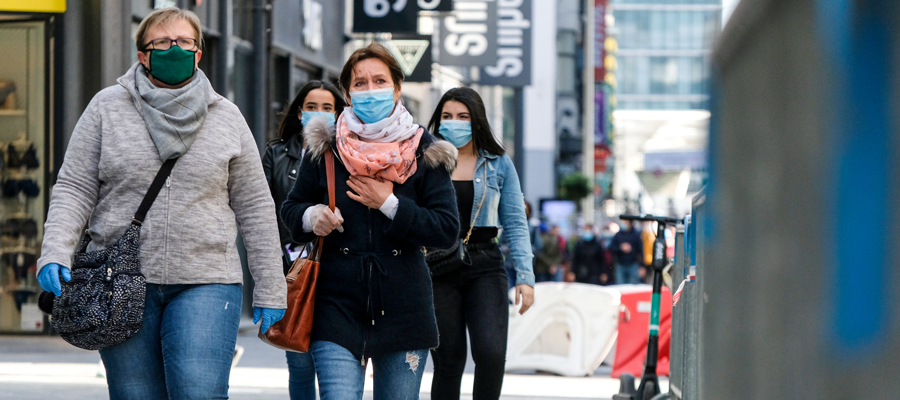Taking stock of COVID-19 economic policy measures in BC

A multitude of measures have been tabled by the provincial and federal governments to prop up workers and an economy reeling from mandated closures of businesses brought about by physical distancing measures. Spring 2020 will be a period economic historians will be writing about for decades to come.
Most economists were encouraging significant fiscal and monetary stimulus when it became clear that containing the pandemic would have massive employment and economic impacts. The central economic task is to prevent what is already expected to be a deep recession from becoming a full-blown depression. As much as possible, we want to avoid seeing tenants evicted, businesses fail, or workers lose income, which would increase hardship and make rebooting the economy much harder. We need to quickly get money into the hands of households so they can pay their bills.
The central economic task is to prevent what is already expected to be a deep recession from becoming a full-blown depression.
So let’s take stock of what has been announced to date federally and in BC.
Federal supports
The federal government is taking the lead on income support for individuals and business, as is appropriate given its bigger fiscal capacity. This effort is being backed by the Bank of Canada, which is engaging in quantitative easing (buying up to $5 billion per week in Government of Canada bonds) to support federal efforts. This is on top of the Bank having dropped its overnight lending rate to 0.25%, as low as it was during the 2008/09 financial crisis and essentially at the limit of conventional monetary policy.
There are two principal channels by which the feds are supporting businesses and workers. The first is a wage subsidy program for businesses, non-profits and charities (Canada Emergency Wage Subsidy or CEWS) that are experiencing a drop in revenues of more than 15 per cent in March and 30 per cent in April and May.¹ It will pay 75 per cent of wages up to a yearly $58,700 maximum (this works out to $847 per week per worker). The current program is in effect for three months, backdated to March 15.
The wage subsidy addresses the harsh reality of businesses whose revenues have dried up and do not have the cash flow to pay expenditures. Businesses can furlough workers under this plan (i.e. keep them on payroll but not have them work), and while they are encouraged to pay some or all of the other 25 per cent, there is no hard obligation to do so. This 75 per cent wage subsidy co-exists with a previously announced 10 per cent wage subsidy program for small businesses and non-profits that don’t meet the 30 per cent drop in revenues test (no double dipping allowed). Some outstanding concerns about the CEWS are raised by Alex Hemingway in this post, and the CCPA is calling for the 75 per cent subsidy to be made immediately available to non-profits and charities rather than force them to wait until revenues plummet before becoming eligible (see this post by Shannon Daub).
The wage subsidy addresses the harsh reality of businesses whose revenues have dried up and do not have the cash flow to pay expenditures.
The second major channel is the Canada Emergency Response Benefit or CERB. Workers who have lost their jobs can get a flat $2,000 per month (for up to 4 months) and it covers many workers who would normally not be eligible for the federal Employment Insurance program. As the program has rolled out, eligibility has been extended to include additional workers, including people who make less than $1,000 a month due to reduced work hours (but not technically unemployed), people who have exhausted EI benefits, and seasonal workers who were waiting for jobs to start. (When the program was launched, about one-third of unemployed Canadians would have received nothing from either CERB or EI, as estimated by the CCPA’s David MacDonald here).2
The CERB is being run out of the Canada Revenue Agency and it is also the gateway for accessing many of the key BC income supports discussed below. The budget cost of this federal measure is currently estimated at $27 billion, and the wage subsidy program a further $71 billion (for comparison, total federal budget expenditures were about $355 billion in 2019/20).
The federal government is also aiming to improve cash flow for households and businesses by allowing deferrals of tax payments (income tax filing and payment, GST remittances and customs duties). Liquidity is the name of the game here, giving flexibility to businesses whose revenues have dropped or been wiped out. The tax deferrals are valued at an estimated $85 billion.
Liquidity is the name of the game here, giving flexibility to businesses whose revenues have dropped or been wiped out.
In addition is a program of $40,000 interest-free loans for small businesses, with those who repay on-time (by end-2022) getting $10,000 forgiven. Several other credit guarantee programs have been established for small and medium-sized enterprises. In total these loan and credit programs will cost $65 billion.
Additional income supports are being delivered through the CRA tax system to lower and modest-income households. The feds announced a one-time $300 per child increase in the Canada Child Benefit, and a bonus payment of the GST tax credit (average of $400 for single individuals, $600 per couple). Using existing payment infrastructure at the CRA means no one will have to apply for these increased benefits.
There are also some very modest federal supports ($300 million in total) for Indigenous communities to address immediate needs and COVID-19 preparedness.
BC supports
BC has arguably done the most of all the provinces in providing additional income supports. The BC stimulus package to date is a total of $5 billion, including funding for increased public services and payments to households.
BC will pay a $1,000 one-time benefit to unemployed workers who qualify for the federal CERB, and has boosted the Climate Action Tax Credit (one-time, to be paid in July 2020) by $174.50 per adult and $51 per child. In addition, via the United Way, BC is funding $50 million in seniors’ supports through community service agencies around the province.
BC has arguably done the most of all the provinces in providing additional income supports.
BC is the only province so far to provide financial relief to renters. The Temporary Renter Supplement will pay directly to landlords $300 per month (for 4 months) for eligible households without dependents and $500 per month for those with dependents. Tenants must fill out a form to determine eligibility, based on: (a) income below a threshold of $74,150 for individuals and couples without dependents and $113,040 for those with dependents; (b) qualifying for the federal CERB, EI or otherwise have a 25% drop in monthly employment income; and (c) paying more than 30% of household income in rent. The application must then be completed by landlords. The application portal only went online April 10, leaving gaps between income and rent in the short term.2
The BC government did not heed calls for rent cancellation, but it did implement a moratorium on evictions (BC Housing had previously announced this for social housing). This means renters without income could stop paying without fear of being evicted in the short term, but unless they have an understanding landlord will likely have to repay all rent owed or face eviction once the ban is lifted.
There was also no parallel initiative that would defer costs for landlords, such as property taxes or mortgage payments (the latter is a federal responsibility, but we note that banks should also absorb a fair share of the financial hit). Finally, the government implemented a freeze on increasing rents as of April 2020 for the remainder of the state of emergency.
Other broad-based BC measures include free bus trips in Metro Vancouver via TransLink (fares still required for Skytrain and Seabus) and the rest of BC Transit operations across the province. BC Hydro reduced its rates by 1% and is providing a one-time credit equivalent to three months of BC Hydro electricity consumption for residential customers who have lost income due to COVID-19 (approximately $135 in savings for the average apartment and $335 for the average single-family home). Small businesses affected by COVID-19 can also apply for a three-month waiver.
Similar to the federal government, BC will also be deferring payments of various business taxes, including the Employer Health Tax, PST, carbon, fuel and tobacco taxes until the Fall. The April 1 scheduled increase in the BC carbon tax has also been delayed. And the provincial portion of commercial property tax is being cut in half (worth $500 million).
Other broad-based BC measures include free bus trips in Metro Vancouver via TransLink and the rest of BC Transit operations across the province.
Most recently, BC announced measures in support of people on social assistance. For those who do not qualify for the CERB, income and disability assistance recipients will get a supplement of $300 per month for the next three months. People on disability who received the $52 bus pass will also get this as cash since most transit has been made free.
Households that are able to access the CERB—because they previously had some income in addition to social assistance—will not have these benefits clawed back off of welfare incomes, as would normally be the case. That is, they will receive the CERB in lieu of the $300/mo increase.
However, no one receiving income assistance will get the bonus $1,000 from the BC government, nor will they be able to access the renter supplement.
Even with the additional $300 per month, income assistance recipients will receive far less than those who get CERB , pointing to a problematic “deserving and undeserving poor” view of hardship. Just as people losing work due to COVID-19 are being affected by something beyond their control, this is also true of the poorest in society (see Iglika Ivanova’s post for more on the changes to social assistance).
For students, both BC and the feds have implemented a freeze on student loan payments until the end of September. BC is also providing some additional emergency financial aid for students ($3.5 million plus $1.5 mil for Indigenous students).
Even with the additional $300 per month, income assistance recipients will receive far less than those who get CERB , pointing to a problematic “deserving and undeserving poor” view of hardship.
In the wake of these new federal and provincial measures, BC is much better prepared to weather the crisis than other provinces, although there are remaining gaps and likely more will be revealed when people start actually applying for and receiving benefits (or finding out that they don’t qualify).
In addition to the above financial measures, the BC government has given itself authority to take over supply chains as needed, and is banning hoarding (imposing limits per shopper) and gouging (preventing the resale of food, medical supplies and cleaning products). The BC government also made a $3 million donation to BC food banks.
In the wake of these new federal and provincial measures, BC is much better prepared to weather the crisis than other provinces
This is an impressive start for Canada and BC, developed in a very short amount of time. That said, much more will need to be done, and soon. The initiatives in total lay bare the shortcomings of neoliberal economics and individualism. Addressing the pandemic has also made clear how frayed our social safety net was to begin with. Many of these new measures that repair our collective institutions should be maintained after the health crisis passes. They demonstrate that we can take better care of each other through our public institutions.
Notes
¹ Updated April 8, 2020
2 Updated April 15, 2020
Topics: COVID-19, Economy, Employment & labour, Provincial budget & finance, Taxes



